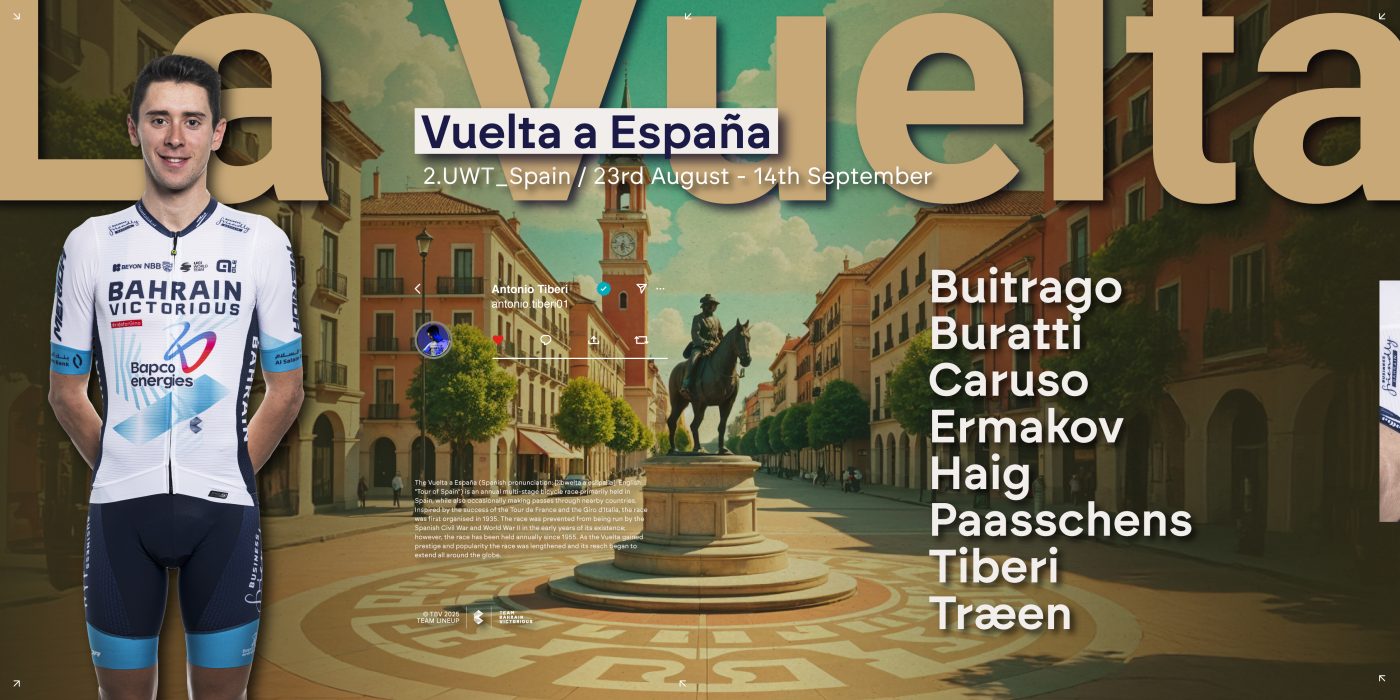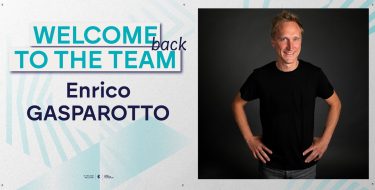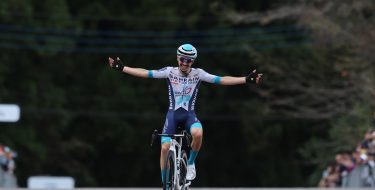La Vuelta a España, the third and final Grand Tour of the season, comes in the midst of a packed week’s racing for Bahrain Victorious, with two other stage races underway in Germany and the Benelux, promising a full weekend for TBV fans.
For the first time in its 90-year history, La Vuelta will start in Italy. After previous starts in France, the Netherlands, and Belgium, this will be the sixth time the Spanish Grand Tour begins on foreign soil.
From Turin to Madrid, the three weeks between 23rd August and 14th September will see the peloton cover 3,151 kilometres across four countries (Italy, France, Andorra, and Spain) and 21 stages, with nearly 55,000 metres of elevation gain and 10 summit finishes. The route is especially suited to climbers, with only four flat stages, one of which ends in an uphill finish.
Paying homage to tradition, this 80th edition will feature legendary passes such as Morredero, Cerler, and Valdezcaray, as well as the return of the Angliru — considered one of the toughest climbs in the world — midway through the race. The showdown will come on the penultimate day atop the Bola del Mundo, returning to La Vuelta for the first time since 2012.
The first major mountain stage comes in Andorra, following the transfer to Spain and a team time trial in Figueres on Stage 5. However, by then the climbing legs will already have been tested. After the flat opener (Torino, Reggia di Venaria – Novara, 186.1 km), Stage 2 (Alba – Limone Piemonte, 159.6 km) features an uphill finish (5.4% average gradient over 7.6 km) and will be an early target for Bahrain Victorious, as lead Sports Director Franco Pellizotti explains:
“We see in this stage an opportunity to strike immediately: to try to take a victory and wear the red jersey as well.”
Bahrain Victorious’ leader for La Vuelta 2025 is Antonio Tiberi, making his fourth appearance at the race. The 24-year-old Italian climber is eager to deliver his best after being forced to abandon last year due to heatstroke on Stage 9, when he was riding strongly, wearing the best young rider’s jersey, and fighting for the GC podium.
“I will have the same aim as at the Giro d’Italia: to target the final podium,” explains Tiberi, who saw his Italian ambitions derailed by a crash. “The whole team believes in me, and that gives me a lot of confidence. I also trust my teammates, with whom I’ve worked very well in preparation for this race. We are here with a solid squad.
The course suits me better this time, with more long climbs rather than the short, steep ones of the past — those longer ascents suit me more. I’m focused on the General Classification, so I don’t have a specific stage where I want to go for the win. I will always be ready and attentive. If on a mountain stage I feel good and there’s an opportunity, I will try to attack and go for a personal result.”
With Stage 3 (San Maurizio Canavese – Ceres, 134.6 km) also on Italian soil, offering opportunities for breakaways or sprinters on a not-so-flat finale, Stage 4 (Susa – Voiron, 192 km) will take the riders into France through the Alps, with the Col de Montgenèvre and Col du Lautaret to be tackled 70 km from the finish.
“After that stage, riders will fly to Spain, where no rest day awaits them. Instead, one of the main dangers on the road to Madrid is scheduled: the team time trial (Figueres – Figueres, 20 km),” comments Pellizotti.
If the TTT reshapes the GC, climbers will quickly have the chance to regain ground with the ‘Pyrenees days.’ Stage 6 (Olot – Pal, Andorra, 170 km) culminates with a Category 1 summit finish, while Stage 7 (Andorra la Vella – Cerler, Huesca La Magia, 187 km) is the most mountainous of this edition, with over 4,400 metres of climbing across four major ascents.
“The day after (Stage 8, Monzón Templario – Zaragoza, 187 km) is for the sprinters, but I see it as another day to watch for GC riders because of potential echelons,” Pellizotti says.
Stage 9 (Alfaro – Estación de Esquí de Valdezcaray, 195 km) offers a tough challenge before the first rest day in Pamplona, with more than 3,200 metres of climbing and an uphill finish, though only one categorised climb is on the route.
The second week resumes with Stage 10 (Parque de la Naturaleza Sendaviva – El Ferial Larra Belagua, 168 km) in the Navarre region, where an easy start leads into a decisive Category 1 climb on the French-Spanish border.
“Our attention will be drawn to Stage 11 (Bilbao – Bilbao, 167 km). With its typical Basque profile — seven short but punchy climbs — it’s one of the most dangerous stages for GC riders, ending with a technical descent and fast run-in. The aim is to arrive in good spirits and form for the demanding days to follow.”
Stage 12 (Laredo – Los Corrales de Buelna, 143 km) features two early climbs but a flat finish that may suit attackers. Stage 13,(Cabezón de la Sal – L’Angliru, 202 km), on the third Friday, will be decisive. The Angliru (12.5 km at over 10% average, with ramps of 23.5% in the final 3 km) returns after a year’s absence, concluding the race’s longest stage. Two other Category 1 climbs — Alto de Mozqueta and Alto de Cordal — precede it.
In 2023, Santiago Buitrago finished 8th on the Angliru: “It’s the hardest climb I’ve done in my career. You climb it at 9–10 km/h, and the last kilometre never ends. I was lucky to stay with the front riders then. This year, I’d like to do better. It depends how we arrive there and what the team’s goals are. I recovered well after the Tour de France and my injuries, so I’m ready. The course suits climbers, and there are stages I’ve marked — like Andorra, close to home, and mythical climbs like Angliru and Bola del Mundo. Winning there would be unforgettable.”
Stage 14 (Avilés – Alto de la Farrapona, 135 km) is short but demanding with multiple climbs and an uphill finish. Stage 15 (A Veiga/Vegadeo – Monforte de Lemos, 167 km) may favour breakaways before the second rest day in Pontevedra.
“The course offers multiple opportunities for success, while keeping an eye on GC,” Pellizotti continues. “Buitrago will have many chances in the mountains. Caruso, our road captain, is in top shape; Jack Haig, a former podium finisher, knows this terrain well; and Torstein Træen comes from a strong showing in Burgos. With GC our priority, we’ll also remain open to stage opportunities. Nicolò Buratti will contest sprints, while other Grand Tour debutants Mathijs Paasschens and Roman Ermakov will provide crucial support and seek breakaways. Overall, we have a well-balanced squad to fight on every terrain.”
The final week begins with Stage 16 (Poio – Mos.Castro de Herville, 172 km), with four climbs and a summit finish, followed by another important day in the mountains, 137 km from O Barco de Valdeorras to Alto de El Morredero, which ends in another challenging ascent.
Stage 18 is the second time trial (Valladolid – Valladolid, 26 km), a flat course favouring specialists against the clock. It could be decisive for the GC, especially for pure climbers weaker in the discipline.
TBV leader Antonio Tiberi on the ITT course:
“It is very similar to the 2023 edition, and it suits me well. It’s very fast and quite long, which I like. I will try to gain as much time as possible on my GC rivals. Since it comes in the last week, we have to consider the factor of accumulated fatigue — everybody will be tired, and that can make an even bigger difference.”
Before the finale in Madrid (Stage 21, Alalpardo – Madrid, 101 km), sprinters may find an opportunity on Stage 19 (Rueda – Guijuelo, 159 km), while the GC battle will likely rage on Stage 20 (Robledo de Chavela – Bola del Mundo, 156 km). Featuring a series of climbs leading to the final ascent of Bola del Mundo (2,200m), its last 3.2 km average 12.2% — likely the ultimate judge of who will be crowned winner of La Vuelta 2025.
The 80th edition of cycling’s third ‘Grand Tour’ always offers opportunities for GC riders to end the season on a high, and 2025 is no exception. With names like Vingegaard, Almeida and Pedersen on the startlist, alongside our own Tiberi, Buitrago, Haig, Caruso et al, this promises to be one of the most hotly contested Vueltas in recent memory.



